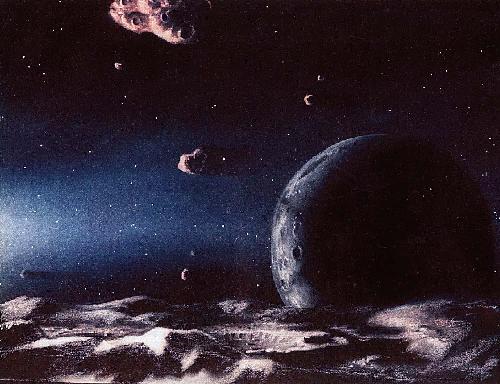
Exothermic
Crystallization and Thermal Models of Icy Bodies
The energy release based on experiments is about 90,000 J/kg.
This energy release, under certain circumstances, might be
enough to significantly alter the temperature structure in
an (initially) icy body. The release is invoked in complicated
numerical models by
Dina
Prialnik and colleagues to explain
many aspects of cometary outgassing. She finds that runaway
transformation is possible: energy released from one element
of amorphous ice is sufficient to trigger transformation of
adjacent elements, and so on. A wave of crystallization is
the result, in her models.
There are two concerns about the crystallization models, one
probably valid and one probably not.
Is the ice initially amorphous?
The models assume that the ice is initially amorphous,
but perhaps it is not.
This is very hard to test: the main validation of the presence
of amorphous in the interiors of comets and KBOs is the success
of the models. But the models involve many free and unknown
parameters, leaving the sneaking suspicion that they might "fit the
data" no matter what. Observations (of KBOs, at least) show that
the surface ice is mainly crystalline, but the surface is not
representative of the bulk.
Is the transition really exothermic in nature?
Akira
Kouchi has argued that the reaction is NOT exothermic for
an impure (i.e. realistic) ice sample,
because volatiles trapped within the amorphous ice sublimate
upon transition and carry away the energy from the crystallization,
leaving none for heating.
This argument is correct for the ice within a few mean-free paths
of the surface of the comet or KBO. For the vast bulk of the ice
beneath this surface skin, though, Kouchi's effect is unimportant,
because the sublimated molecules re-impact ice nearby and freeze
there, so returning their energy of vaporization. The energy remains
available for heating, as needed in the runaway models. At least,
that's the way it looks to me.
 Kuiper Belt
Kuiper Belt
